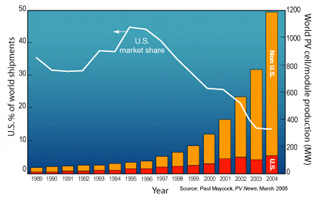|
|
|

|
| Incentives for Solar Energy |
| Most 50 states and the
District of Columbia offer financial incentives to help
support solar energy investment. As of July 2006, California
provides a $2.20 per watt rebate. This can result in savings
of up to 50% on the system’s total purchase price. In other
states, the incentives can be even more generous. For example,
New Jersey currently offers rebates of $5.50 per watt,
resulting in net savings of as much as 70%. For information on
state and federal net metering, cash rebates, accelerated
depreciation, tax incentive programs, feed-in tariffs, and
renewable energy (“green”) credits, consult the Database of
State Incentives for Renewable Energy, funded by the U.S.
Department of Energy at
www.dsireusa.org. |
| |
| Solar Energy Benefits |
| Economic Benefits:
Delivers power at a fixed price over twenty years versus the
escalating and unpredictable costs of oil, gas, and grid
electricity. Lessens our collective dependence on foreign oil
imports, contributing to the balance of trade, and to national
energy security. Creates local jobs. |
Environmental Benefits:
Slows the burning of fossil fuels, the largest contributor of
green house gas emissions, and air pollution. Preserves
natural habitats that are often damaged or destroyed by oil,
gas, and coal exploitation. Saves forests that are often cut
down for cooking and heating purposes.
|
| Social Benefits:
Provides vital resources to the millions of people worldwide
who lack access to reliable power or safe drinking water.
Increases availability of electronic communications and can
help stem mass migration to crowded urban centers. |
|
|
|

